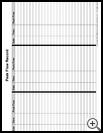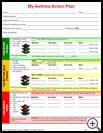
Peak Flow Meter
What is a peak flow meter?
A peak flow meter is a small hand-held device that measures how well air moves out of your child’s lungs. It does this by measuring how fast your child can blow air out of his lungs. It is a way to tell how well your child is breathing. Peak flow readings tell you if your child's asthma is in good control, if your child needs to take medicine, or if you need to get help right away.
Measuring the peak flow regularly can help detect an asthma attack before it becomes noticeable. Also, using the colored zone system (green, yellow, red) with the peak flow meter will help you know when your child needs help and how to better manage your child's asthma.
One type of peak flow meter has a sliding marker that moves as your child blows air forcefully into the device. At the end of a forceful breath, the marker stops at a place on a numbered scale that measures the amount of air your child breathed out. The numbered scale usually ranges from 0 to 750.
Digital peak flow meters record each reading in the device. This should not replace using a chart to record your child's peak flow readings. Some units also display "traffic light" colored peak flow zones based on the child's personal best peak flow reading. An added benefit is that some digital peak flow meters also measure FEV1 (the amount of air blown out in the first second). Some devices have the ability to electronically transmit results to the healthcare provider. This can make it easier to track and compare readings.
There are several different types of peak flow meters, so for accurate readings, it is very important to understand how to use the peak flow meter and to follow instructions carefully. It is also important to use the same peak flow meter for all readings.
When should my child use a peak flow meter?
First you need to figure out your child's personal best peak flow reading. This is done by taking peak flow measurements twice a day for a couple of weeks when your child is feeling well and his asthma is under good control. At the end of the 2 or 3 weeks, look over the numbers and pick out the highest readings. These readings determine your child’s personal best peak flow meter reading. Record all of your child's readings on a chart and take the chart to your healthcare provider. The personal best reading will give you and your provider something to judge all of your child's future peak flow readings against.
Your healthcare provider may recommend that your child keep a daily record of the peak flow readings or suggest that your child take readings 2 or 3 times a week.
- Daily use: If your child needs to record his peak flow every day, the first reading should be a morning reading (before taking any medicine). If the reading is less than 80% of the personal best, have your child take his quick-relief (reliever) medicine, then wait 15 minutes and test again. Take a peak flow reading in the early afternoon if your child's morning peak flow reading is less than 80% of his personal best. Taking another measurement before taking medicines in the evening is often recommended.
- Weekly use: If your child only needs to take readings a few times a week, take a reading in the morning and again in the evening each day that you take a measurement. Measure the peak flow before taking inhaled medicine. If a quick-relief (bronchodilator) medicine is used, repeat the peak flow 15 minutes after taking the medicine and record any change. If the morning and evening readings are different by more than 20%, talk to your healthcare provider about how to manage the asthma better.
Use a chart to record your child's peak flow readings along with the date and time of day the readings are taken.
You should also measure your child's peak flow reading when your child has an asthma attack. Measure your child’s peak flow both before and after using the quick relief medicine to check how well the medicine is working.
You should recheck your child’s personal best reading every year or whenever you get a new meter.
What do the peak flow numbers mean?
Because lung capacity is not the same for everyone, personal best peak flow readings are different. Your healthcare provider will give you guidelines to follow based on your child's personal best reading. In general, if your child has a peak flow that is 80% (or better) of his personal best, it means that the asthma is under control. A number between 50% and 80% of the personal best means that your child needs to take a quick-relief medicine. Lower than 50% means that your child is having serious asthma symptoms and needs immediate help.
How is the peak flow meter used?
Each brand of peak flow meter works a little differently. Carefully read and follow the instructions included with your meter. Make sure your child tries to do the test correctly. You will not get an accurate reading if your child does not give his best effort.
General instructions are:
- Place the mouthpiece on the peak flow meter. (Some meters have different sizes of mouthpieces for younger and older children and some do not have mouthpieces at all.)
- Place the marker at the bottom of the numbered scale (zero or the lowest number on the scale).
- Hold the peak flow meter upright, being careful that fingers do not block the opening.
- Have your child stand up and take the biggest, deepest breath he can with his mouth open. Place the mouthpiece into his mouth beyond the teeth and have him make a tight seal around the mouthpiece with his lips. Be sure that his tongue does not block the opening of the mouthpiece.
- Have your child blow out as hard and fast as he can. (If your child coughed or made a mistake, do not record the number. Do it over again.)
- Have your child take the mouthpiece out of his mouth. The marker will have moved up the scale and stopped at the point that is the peak flow measurement. Write down the number.
Repeat this procedure 2 more times. Write down each number and circle the highest reading from the 3 tries. Record the date and time of day with this number.
When and how should the peak flow meter be cleaned?
The mouthpiece of the meter should be cleaned weekly with warm soapy water. Rinse and dry it well.
Last modified: 2011-09-09
Last reviewed: 2010-12-13


